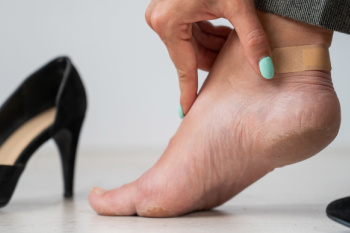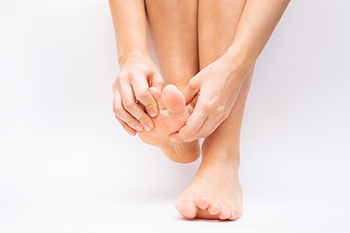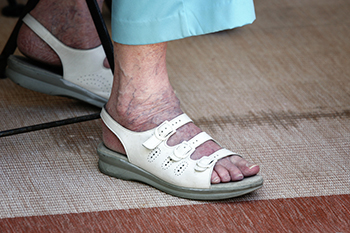Connect With Us
Blog
Items filtered by date: April 2024
Origins of Blisters on the Feet

Blisters on the feet can be an unwelcome nuisance, often causing discomfort and hindering mobility. These fluid-filled sacs typically form in response to friction or repetitive rubbing against the skin. When excessive pressure or irritation occurs, the outer layer of the skin separates from the underlying tissue, creating a protective bubble filled with fluid. Common culprits behind blister formation include wearing ill-fitting shoes, prolonged periods of walking or running, and friction caused by sweaty or damp conditions. Additionally, certain activities, such as hiking or wearing new shoes without proper breaking in, can increase the likelihood of developing blisters. Individuals with foot deformities or abnormalities may also be more prone to blister formation due to uneven pressure distribution. If you have a blister on your foot that has become infected, it is suggested that you consult a podiatrist who can safely treat it and provide effective prevention techniques for future knowledge.
Blisters may appear as a single bubble or in a cluster. They can cause a lot of pain and may be filled with pus, blood, or watery serum. If your feet are hurting, contact Rahil Baxamusa, DPM of Illinois. Our doctor can provide the care you need to keep you pain-free and on your feet.
Foot Blisters
Foot blisters are often the result of friction. This happens due to the constant rubbing from shoes, which can lead to pain.
What Are Foot Blisters?
A foot blister is a small fluid-filled pocket that forms on the upper-most layer of the skin. Blisters are filled with clear fluid and can lead to blood drainage or pus if the area becomes infected.
Symptoms
(Blister symptoms may vary depending on what is causing them)
- Bubble of skin filled with fluid
- Redness
- Moderate to severe pain
- Itching
Prevention & Treatment
In order to prevent blisters, you should be sure to wear comfortable shoes with socks that cushion your feet and absorb sweat. Breaking a blister open may increase your chances of developing an infection. However, if your blister breaks, you should wash the area with soap and water immediately and then apply a bandage to the affected area. If your blisters cause severe pain it is important that you call your podiatrist right away.
If you have any questions, please feel free to contact our office located in Crystal Lake, IL . We offer the newest diagnostic and treatment technologies for all your foot care needs.
Causes of Big Toe Joint Pain

Big toe joint pain can be a nagging and debilitating issue, affecting mobility and daily activities. Understanding the root causes is imperative to finding effective relief and restoring comfort to your feet. One common culprit is osteoarthritis, a degenerative joint disease characterized by the breakdown of cartilage in the joints. When osteoarthritis affects the big toe joint, it can lead to pain, stiffness, and swelling, particularly during movement or weight-bearing activities. Another potential cause is gout, a type of arthritis caused by the buildup of uric acid crystals in the joints, resulting in sudden and intense pain in the big toe joint. Additionally, injuries such as sprains or fractures, as well as conditions like bunions or sesamoiditis, can contribute to big toe joint pain. Identifying the specific cause through a thorough evaluation by a podiatrist is essential for developing an appropriate treatment plan tailored to your needs. If you have big toe pain, it is suggested that you consult a podiatrist who can accurately determine what the cause is, and offer appropriate treatment methods.
Toe pain can disrupt your daily activities. If you have any concerns, contact Rahil Baxamusa, DPM of Illinois. Our doctor can provide the care you need to keep you pain-free and on your feet.
What Causes Toe Pain?
Most severe toe pain is caused due to a sports injury, trauma from dropping something heavy on the toe, or bumping into something rigid. Other problems can develop over time for various reasons.
Toe pain can be caused by one or more ailments. The most common include:
- Trauma
- Sports injury
- Wearing shoes that are too tight
- Arthritis
- Gout
- Corns and calluses
- Hammertoe
- Bunions
- Blisters
- Ingrown toenails
- Sprains
- Fractures (broken bones)
- Dislocations
When to See a Podiatrist
- Severe pain
- Persistent pain that lasts more than a week
- Signs of infection
- Continued swelling
- Pain that prevents walking
Diagnosis
In many cases the cause of toe pain is obvious, but in others, a podiatrist may want to use more advanced methods to determine the problem. These can range from simple visual inspections and sensation tests to X-rays and MRI scans. Prior medical history, family medical history, and any recent physical traumatic events will all be taken into consideration for a proper diagnosis.
Treatment
Treatments for toe pain and injuries vary and may include shoe inserts, padding, taping, medicines, injections, and in some cases, surgery. If you believe that you have broken a toe, please see a podiatrist as soon as possible.
If you have any questions please feel free to contact our office located in Crystal Lake, IL . We offer the newest diagnostic tools and technology to treat your foot and ankle needs.
Reminder: When Was the Last Time...?
The Importance of Caring for Elderly Feet

Elderly feet require special attention and care due to the natural aging process and the accumulation of years of wear and tear. As individuals age, the skin becomes thinner and loses elasticity, making it more susceptible to injury and infection. Conditions like arthritis and diabetes, common among the elderly, further compound foot health issues, increasing the risk of complications such as neuropathy, deformities, and slow wound healing. Reduced mobility and circulation also contribute to foot ailments, including swelling, stiffness, and decreased sensation. Neglecting foot health can lead to discomfort, pain, and mobility limitations, significantly impacting quality of life. Regular foot inspections, proper hygiene, and wearing supportive footwear are essential preventative measures. Seeking prompt medical attention for any signs of infection, injury, or discomfort is essential to prevent complications and maintain overall well-being. If you are a senior, or caring for an elderly individual, it is suggested that routine visits are made to a podiatrist where various foot conditions can be treated.
Proper foot care is something many older adults forget to consider. If you have any concerns about your feet and ankles, contact Rahil Baxamusa, DPM from Illinois. Our doctor can provide the care you need to keep you pain-free and on your feet.
The Elderly and Their Feet
As we age we start to notice many changes in our body, but the elder population may not notice them right away. Medical conditions may prevent the elderly to take notice of their foot health right away. Poor vision is a lead contributor to not taking action for the elderly.
Common Conditions
- Neuropathy – can reduce feeling in the feet and can hide many life-threatening medical conditions.
- Reduced flexibility – prevents the ability of proper toenail trimming, and foot cleaning. If left untreated, it may lead to further medical issues.
- Foot sores – amongst the older population can be serious before they are discovered. Some of the problematic conditions they may face are:
- Gouging toenails affecting nearby toe
- Shoes that don’t fit properly
- Pressure sores
- Loss of circulation in legs & feet
- Edema & swelling of feet and ankles
Susceptible Infections
Diabetes and poor circulation can cause general loss of sensitivity over the years, turning a simple cut into a serious issue.
If you have any questions please feel free to contact our office located in Crystal Lake, IL . We offer the newest diagnostic and treatment technologies for all your foot and ankle needs.
Common Causes of Ankle Pain

Ankle pain, a prevalent discomfort that can significantly impede daily activities, stems from various underlying factors. One primary cause is ankle sprains, resulting from sudden twists or rolls of the foot, leading to ligament damage and inflammation. Similarly, overuse injuries, such as tendinitis, occur when tendons become inflamed due to repetitive stress or strain, commonly observed in athletes or individuals engaged in strenuous physical activities. Additionally, arthritis, a condition characterized by joint inflammation, can affect the ankle joint, causing pain, stiffness, and swelling. Fractures, often caused by falls, accidents, or high-impact injuries, also contribute to ankle pain, necessitating immediate medical attention. Furthermore, conditions like Achilles tendinitis, plantar fasciitis, and nerve compression syndromes can manifest as ankle discomfort. If you have ankle pain, it is suggested that you visit a podiatrist who can determine what the cause is, and offer you effective relief and treatment options.
Ankle pain can be caused by a number of problems and may be potentially serious. If you have ankle pain, consult with Rahil Baxamusa, DPM from Illinois. Our doctor will assess your condition and provide you with quality foot and ankle treatment.
Ankle pain is any condition that causes pain in the ankle. Due to the fact that the ankle consists of tendons, muscles, bones, and ligaments, ankle pain can come from a number of different conditions.
Causes
The most common causes of ankle pain include:
- Types of arthritis (rheumatoid, osteoarthritis, and gout)
- Ankle sprains
- Broken ankles
- Achilles tendinitis
- Achilles tendon rupture
- Stress fractures
- Bursitis
- Tarsal tunnel syndrome
- Plantar fasciitis
Symptoms
Symptoms of ankle injury vary based upon the condition. Pain may include general pain and discomfort, swelling, aching, redness, bruising, burning or stabbing sensations, and/or loss of sensation.
Diagnosis
Due to the wide variety of potential causes of ankle pain, podiatrists will utilize a number of different methods to properly diagnose ankle pain. This can include asking for personal and family medical histories and of any recent injuries. Further diagnosis may include sensation tests, a physical examination, and potentially x-rays or other imaging tests.
Treatment
Just as the range of causes varies widely, so do treatments. Some more common treatments are rest, ice packs, keeping pressure off the foot, orthotics and braces, medication for inflammation and pain, and surgery.
If you have any questions, please feel free to contact our office located in Crystal Lake, IL . We offer the newest diagnostic and treatment technologies for all your foot care needs.
Facts About Cuboid Syndrome

Cuboid syndrome, a lesser-known foot ailment, often eludes mainstream attention. However, its impact can be significant for those affected. This condition occurs when the cuboid bone, situated in the outer midfoot, becomes dislocated or irritated, leading to discomfort and limited mobility. Typically overlooked or misdiagnosed, Cuboid syndrome manifests through symptoms like pain along the outer foot, swelling, and difficulty in bearing weight. One of the perplexing aspects of cuboid syndrome is its elusive nature, often mimicking other foot conditions, complicating accurate diagnosis. It commonly arises from activities involving repetitive stress or sudden trauma to the foot, such as running, dancing, or jumping. Additionally, certain foot structures and gait abnormalities can predispose individuals to this syndrome. Despite its obscurity, recognizing the signs and seeking timely treatment is critical for managing cuboid syndrome effectively. If you have pain in this part of your foot, it is suggested that you consult a podiatrist who can accurately diagnose and treat cuboid syndrome.
Cuboid syndrome, also known as cuboid subluxation, occurs when the joints and ligaments near the cuboid bone in the foot become torn. If you have cuboid syndrome, consult with Rahil Baxamusa, DPM from Illinois. Our doctor will assess your condition and provide you with quality foot and ankle treatment.
Cuboid syndrome is a common cause of lateral foot pain, which is pain on the outside of the foot. The condition may happen suddenly due to an ankle sprain, or it may develop slowly overtime from repetitive tension through the bone and surrounding structures.
Causes
The most common causes of cuboid syndrome include:
- Injury – The most common cause of this ailment is an ankle sprain.
- Repetitive Strain – Tension placed through the peroneus longus muscle from repetitive activities such as jumping and running may cause excessive traction on the bone causing it to sublux.
- Altered Foot Biomechanics – Most people suffering from cuboid subluxation have flat feet.
Symptoms
A common symptom of cuboid syndrome is pain along the outside of the foot which can be felt in the ankle and toes. This pain may create walking difficulties and may cause those with the condition to walk with a limp.
Diagnosis
Diagnosis of cuboid syndrome is often difficult, and it is often misdiagnosed. X-rays, MRIs and CT scans often fail to properly show the cuboid subluxation. Although there isn’t a specific test used to diagnose cuboid syndrome, your podiatrist will usually check if pain is felt while pressing firmly on the cuboid bone of your foot.
Treatment
Just as the range of causes varies widely, so do treatments. Some more common treatments are ice therapy, rest, exercise, taping, and orthotics.
If you have any questions, please feel free to contact our office located in Crystal Lake, IL . We offer the newest diagnostic and treatment technologies for all your foot care needs.
Blog Archives
- May 2024
- April 2024
- March 2024
- February 2024
- January 2024
- December 2023
- November 2023
- October 2023
- September 2023
- August 2023
- July 2023
- June 2023
- May 2023
- April 2023
- March 2023
- February 2023
- January 2023
- December 2022
- November 2022
- October 2022
- September 2022
- August 2022
- July 2022
- June 2022
- May 2022

